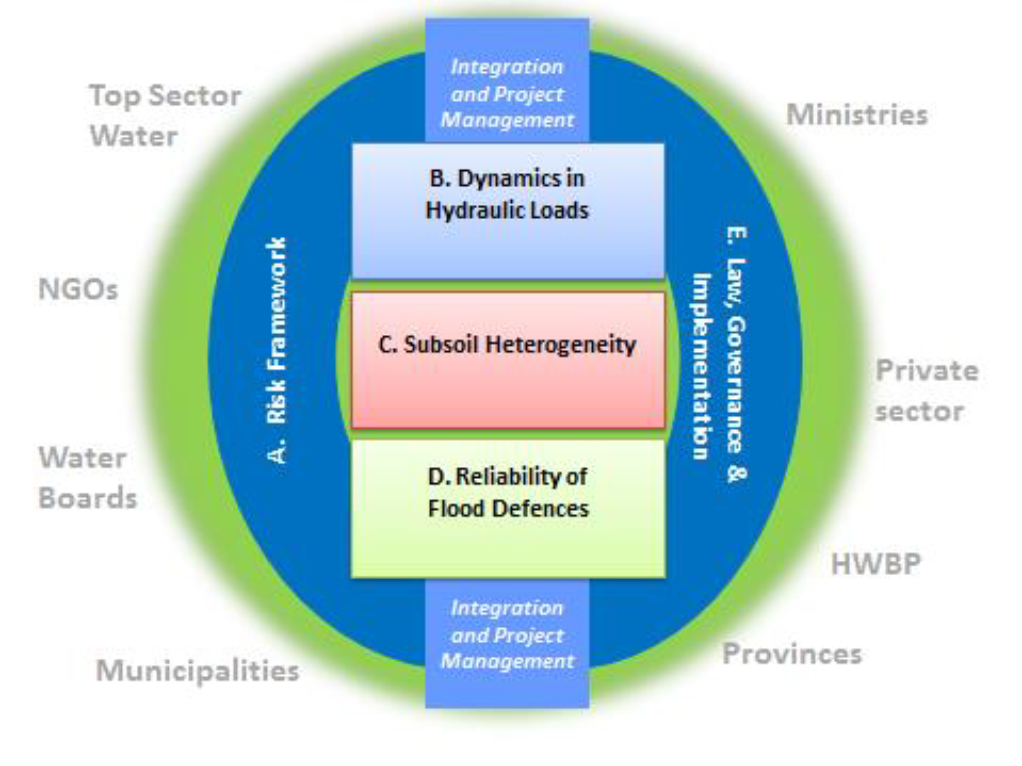All-risk: Implementation of new risk standards Dutch flood protection program
From the 1st of January 2017 new legal safety standards are used for flood protection in the Netherlands. In many places these safety standards reduce risks by more than a factor 10. The Dutch Flood Protection Program implements flood protection measures that enable satisfying these safety standards. The program is ambitious: over 2/3s of all primary flood defences will have to be reinforced at an increased pace and decreased cost, compared to past reinforcements.
At the end of 2016 NWO awarded funding for the research program All-Risk to support the Flood Protection Program. The program is led by prof.dr.ir. Matthijs Kok (professor of Flood Risk at the section of Hydraulic Structures & Flood Risk) and ir. Richard Jorissen (director at the Flood Protection Program). Five universities (TU Delft, Utrecht, Wageningen, Twente and Nijmegen) participate in the program. The goal is to support the Flood Protection Program with targeted research. The program consists of a multidisciplinary group of 15 PhD-researchers and 4 Postdocs. About 70% of the research is aimed at enhancing technical knowledge on dike reinforcements whereas about 30% deals with more integrating aspects such as landscaping, ecological aspects, multifunctionality and governance arrangements. International collaborations with universities in Houston, Tokyo and Berlin ensure international relevance of the research.
An important aspect of the program is that over 30 users (Rijkswaterstaat, water authorities, SMEs, larger consultants and research institutes) contribute actively to the program with both time and money. This shows that the challenges faced by the Flood Protection Program are widely recognized by practitioners in the field. The program has started in the summer of 2017.
At the section of Hydraulic Structures and Flood Risk 5 PhD-researchers and 1 Postdoc are working on the program.
Wim Kanning works as a part-time Post-Doctoral researcher in All-Risk. His main tasks within All-Risk are the supervision and PhD candidates and MSc students. Furthermore he carries out general project tasks to enable integration of the various projects and performs research. His main research interests are reliability analyses and the backward erosion piping mechanism in dikes.
Wouter Jan Klerk is improving approaches for risk-based asset management of dikes. Here he focuses mainly on the development of integrated approaches for strategies consisting of inspection, monitoring and a variety of new and more conventional techniques for dike reinforcement. Major part in this research is the analysis of relevant uncertainties and their effects in short, medium and long-term decision making, and what measures have to be taken to assure the required reliability is met during the life-cycle of a flood defence.
Mark van der Krogt is working on incorporating the performance of dikes in failure probability analyses. The observational method is used to include monitoring and observations of historical or imposed (not) survived loads. Examples are extreme water levels, loading by staged construction or test loads.
Joost Pol is working on time dependence (e.g. piping advancement rates and time lags in slope instability) and interaction in failure processes (e.g. effects of overtopping erosion on slope stability and vice versa) and their quantification in dike reliability analysis. The potential of event trees to quantify the effects of these processes on reliability in practice is studied.
Christopher Lashley is looking at wave propagation over foreshores and the overall impact of these nature-based measures on the probability of dike failure by overtopping waves. In particular, his research will focus on the generation, propagation and dissipation of long-period (infragravity waves) which dominate shallow environments. His project aims to reduce the uncertainty in wave loads by taking into account the influence of the foreshore on wave run-up and overtopping of dikes.
Arny Lengkeek is working on performance based design of stability walls in dikes. Stability walls are more frequently used in projects to stabilize the dikes, in particular when the most practical strengthening measure like widening is not possible because of houses/objects. The stability, deformations and structural forces can only be determined with models that account for soil-structure interaction (SSI). In civil/geotechnical engineering there is relevant experience with SSI, but not yet in dike design. Together with HWBP/POVM a full-scale field test of a dike with/without sheet pile will be performed (Damwandproef-Eemdijk), this will be the basis for my research.
The full program can be found here.
